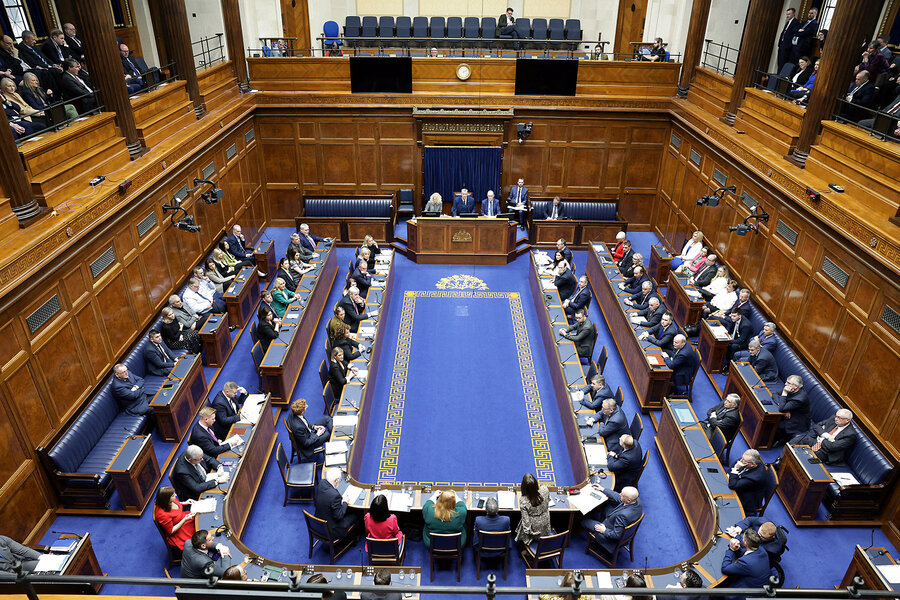Northern Ireland’s lessons for Gaza: Peace is possible
Loading...
| London
A historic session in the Northern Ireland Assembly last weekend had a powerful message for world leaders seeking a cease-fire in Gaza and a path toward eventual Israeli-Palestinian peace.
It was that peace is possible. And that Northern Ireland’s decades of sectarian killing and years of failed peace efforts, crowned finally by a breakthrough requiring compromise, offer lessons.
Why We Wrote This
Amid intense conflict, such as in Gaza, even the mention of peace can seem naive. But history shows that a tenacious commitment to it can break through seemingly irreconcilable differences.
The Northern Ireland dispute has deep historical roots, growing out of centuries of Anglo-Irish tension and ultimately all-out war. Cease-fires were agreed to and broken. There were efforts to reach a political solution, including one in 1973 containing many elements of the future Good Friday Agreement that finally ended the civil war in 1998.
Important shifts undergirded that success. Catholic and Protestant paramilitaries realized they could not achieve by force what they wanted politically. The British government wanted to disengage troops. Negotiators saw that resolving emotive issues – jailed paramilitaries, for instance – meant they had to secure the buy-in of paramilitaries themselves. International support was key.
Now neither party wants a return to the bad old days. Instead, as the new Catholic first minister said and her Protestant fellow minister echoed, “What we can do is build a better future.”
The contrast between Northern Ireland’s parliamentary decorum and the violence engulfing Gaza 2,500 miles away could not have been more striking.
Yet the historic session in Belfast’s assembly last weekend had a powerful message for U.S., European, Arab, and other world leaders seeking not just a cease-fire in Gaza but also a path toward eventual Israeli-Palestinian peace.
It was that peace is possible, even in the most seemingly intractable conflicts. And that Northern Ireland’s experience – decades of sectarian killing and years of failed peace efforts, crowned finally by a breakthrough requiring compromise on all sides – could hold lessons for would-be peacemakers in the Middle East.
Why We Wrote This
Amid intense conflict, such as in Gaza, even the mention of peace can seem naive. But history shows that a tenacious commitment to it can break through seemingly irreconcilable differences.
Last Saturday’s proceedings in Northern Ireland’s Parliament Buildings would have been unthinkable before the 1998 Good Friday Agreement, which ended the civil war there.
The paramilitary violence pitted the province’s Protestant majority, intent on remaining part of Britain, against a Catholic minority striving to reunite with Catholic Ireland. A large British army force was brought in to try to rein in the violence.
Yet since then, the Catholics have gradually become a slight majority. In the last election, Sinn Fein, the political arm of the Catholic paramilitaries during the fighting, won the most seats.
So in an unprecedented turn of political events, a Sinn Fein leader was being sworn in as first minister, with the Protestants’ Democratic Unionist Party filling the unfamiliar role of deputy first minister.
Still, the mood was conciliatory. Both new ministers vowed to work together for the good of all communities.
That may have been partly because the architecture of post-Good Friday Agreement government requires the support of both ministers – both communities – for any government decision. Yet it also reflected a new reality: Neither community wants a return to the bad old days.
So are there implications for the similarly intractable Israeli-Palestinian conflict?
While the mere fact of Northern Ireland’s peace could offer hope, the more immediately relevant lessons may lie in how, after many failed efforts, the 1998 agreement was ultimately achieved.
Centuries of tension
The Northern Ireland dispute, like the Middle East conflict, has deep historical roots.
It grew out of centuries of Anglo-Irish tension, escalating into all-out war early in the 20th century. At the end of that fighting, in 1921, Ireland secured independence, but its northeasternmost provinces were hived off into the separate territory of Northern Ireland, tying the then-majority-Protestant population to London.
The decades of violence, beginning in the 1960s, were driven by two incompatible, and apparently irreconcilable, visions: for Protestants, permanent union with Britain; for Catholics, a locally disadvantaged minority, a reunited Ireland.
As in the efforts to resolve Israel’s conflict with the Palestinians, cease-fires were agreed to and broken along the way. There were also efforts to reach a political solution, including one in 1973 containing many elements of the Good Friday Agreement a quarter century later.
There were important reasons the 1998 effort succeeded where others had faltered.
The context of the conflict had changed dramatically. Both Catholic and Protestant paramilitaries had come to realize that they could not achieve by force what they wanted politically. The British government was explicitly looking for a way to disengage its troops as well.
The negotiators also came to recognize that resolving some of the most emotive issues – the fate of jailed paramilitaries, for instance, and the decommissioning of weapons and explosives – meant they had to secure the buy-in of the paramilitaries themselves.
Finally, extraordinary political tenacity and leadership were required – ultimately from Northern Ireland’s political leaders, but no less importantly from then-British Prime Minister Tony Blair and Ireland’s former head of government, Bertie Ahern. And, critically, from an outside player: U.S. President Bill Clinton, intervening both personally and through special envoy George Mitchell, who drew on trust from all sides to help navigate issues like arms decommissioning, steer the talks, and bring them across the finish line.
The problem for Middle East peacemakers is that there, the context hasn’t shown signs of change. Far from concluding that violence won’t achieve their aims, ever since Hamas’ kidnappings and killings on Oct. 7, both sides seem to believe there’s no alternative.
Some potential hope, however, may lie in the example of the Good Friday Agreement’s reliance on resolute outside support – in the case of Israel and the Palestinians, from the Biden administration and the Arab partners it has been enlisting to help present a credible political alternative.
As Northern Ireland has shown, that carries the potential to prove transformative.
Catholics and Protestants still profoundly disagree about the province’s future. Though no longer killing each other, they are not greatly more integrated with, or more trustful of, each other than they were before 1998.
Still, there has been fundamental change. In her remarks last Saturday, Sinn Fein’s new first minister, Michelle O’Neill, described herself as part of the “Good Friday” generation.
She said the years of war, and the thousands of victims on all sides, shouldn’t be forgotten. “The past cannot be changed or undone.”
But in sentiments echoed by her Protestant fellow minister, she added, “What we can do is build a better future.”











